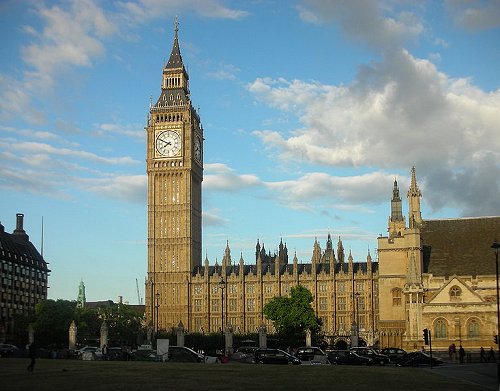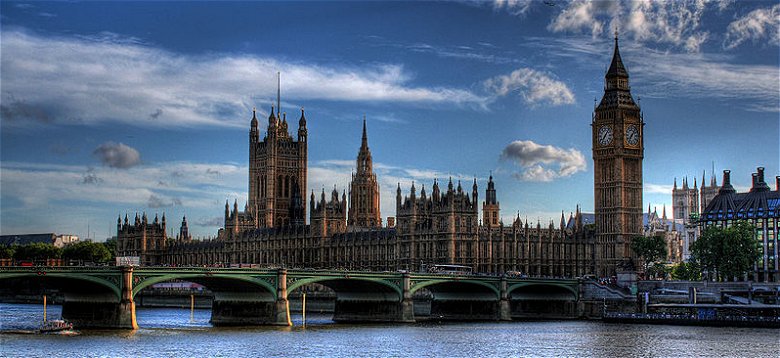The Palace of Westminster, also known as the Houses of Parliament or Westminster Palace, is the parliament house of the United Kingdom. The Palace, and especially its Clock Tower, is one of the most recognisable icons of London and the United Kingdom. It is also one of the most visited tourist attractions of London. The Palace of Westminster is located on the north bank of the River Thames which due to the bent in that section of the river, it is on the west side of the Thames, in the London borough of the City of Westminster, in proximity to the other government buildings in Whitehall.
The Palace of Westminster is one of the biggest parliament houses in the world. It contains 1,200 rooms, 100 staircases, over 3km of corridors. Most of it dates back to 1834, following a fire that burned down the earlier building. Only the Westminster Hall, used for public ceremonial events such as lying in state, and the Jewel Tower, were older.
During that time, the Palace of Westminster was the king's main residence. At that time, there was no parliament. Instead, there was the King's court, called Curia Regis, or Royal Council. They are the forerunner of Parliament, and are composed of tenants-in-chief and ecclesiastics. Tenants-in-chief are people who held lands directly from the King. They are called earls and barons, and their territory called manors. The ecclesiastics are religous leaders, such as the archbishops, bishops and abbots. The Royal Council met in Westminster Hall, but followed the King wherever he moved. The first official Parliament of England met at the Palace of Westminster in 1295.
The Palace of Westminster continued to be the king's main residence until 1529. That's the year it caught fire that destroyed parts of it. In 1530 Henry VII took over York Palace, renamed it the Palace of Whitehall and made it his main residence. The Palace of Westminster continued to be used by the two Houses of Parliament and as a law court. As it was intended to be a royal palace, the Palace of Westminster was not built for the purpose of parliament. Important ceremonies, such as the State Opening of Parliament, was held in the Painted Chamber. The House of Lords meet in the White Chamber. The House of Commons did not have a place to meet, and had to meet in the Chapter House of the Westminster Abbey. They only get a permanent home during the reign of Henry VII's successor, King Edward VI, at St Stephen's Chapel, a former royal chapel.
Another fire broke out at the Palace of Westminster in 1834. Only Westminster Hall, the Jewel Tower, the crypt of St Stephen's Chapel and the cloisters survived the fire. A debate broke out as to the style to rebuild the Palace. The neoclassical style, similar to the White House and Congress of USA, was rejected for its connotations of revolution and republic. In the end the Gothic style was chosen. Out of 97 proposals submitted, the one from Charles Barry was chosen. The foundation stone was laid in 1840, the Lord's Chamber was completed in 1847, and the Commons' Chamber in 1852. Barry received a knighthood that year. When he died in 1860, much of the work has been carried out, but it would take another ten years before the Palace of Westminster was fully completed.
The Palace of Westminster, Westminster Abbey and the Church of St Margaret were collectively inscribed by Unesco as a World Heritage Site in 1987.
Getting there
Nearest Tube station: WestminsterBuses: Nos. 3, 12, 77A
Pier: Westminster Millennium Pier
Tours: Tour of the Houses of Parliament is available during the summer recess, from July-August, Mon/Tues/Fri/Sat: 9:15am-4:30pm, Wed/Thurs: 1:15pm-4:30pm; Sep-Oct, Mon/Fri/Sat: 9:15am-4:30pm, Tues-Thurs: 1:15pm-4:30pm. Tour of the Clock Tower is available Mon-Fri at 10:30am, 11:30am and 2:30pm.
What to see
The public tour takes you on the route taken by the Queen at the State Opening of Parliament. You pass through the Norman porch and enter the Queen's Robing Room, which is all gold and crimson. From there, you continue to the Royal Gallery, where portraits of British kings and queens are hung. In the Prince's Chamber are Victorian portraits. Next, the tour takes you to the Lords' Chamber, which is where the Queen addresses Parliament and the Lord Chancellor takes his place on the Woolsack, a wool-stuffed cushion that is to represent the prosperity of the kingdom. From here, you pass through the Peers' Lobby to the Central Lobby. This is where the members of the public can meet their Members of Parliament to plead for their causes - and that's where the verb to lobby originate. A corridor takes you to the Commons Lobby, where a red line marks the division between the Government and the Opposition. Their distance is close, just two swords length apart. You continue the tour to St. Stephen's Hall, site of the original Westminster chapel, and end your tour at the 11th century Westminster Hall, where you can adjourn to the gift shop and cafe.If you wish to attend the debates, you need to wait outside St Stephen's Entrance. At times, the queue to enter can be quite long. If you are a non-British, you should apply to your embassy in UK for a card of introduction allowing you entry during the early afternoon.
If you wish to visit the Clock Tower (where Big Ben, the bell, is located), British residents should apply via their MP while foreign visitors should write, giving 3 months' grace, to Clock Tower Tours, Parliamentary Works Services Directorate, 1 Canon Row, London SW1A 2JN, United Kingdom.
The Palace of Westminster is  on the Map of the City of Westminster, London
on the Map of the City of Westminster, London
 Clocktower of the Clocktower of the Palace of Westminster
Clocktower of the Clocktower of the Palace of WestminsterSource: https://commons.wikimedia.org/wiki/File:Palace_of_Westminster_-_July_2008.jpg
Author: Italo-Europeo

 Victoria Tower, Palace of Westminster
Victoria Tower, Palace of WestminsterSource: https://commons.wikimedia.org/wiki/File:Victoria_Tower_London_April_2006_004.jpg
Author: Gryffindor

 The British House of Parliament
The British House of ParliamentSource: https://commons.wikimedia.org/wiki/File:Hdr_parliament.jpg
Author: Graeme Maclean

List of Historical buildings in London

Copyright © 2003-2025 Timothy Tye. All Rights Reserved.

 Go Back
Go Back